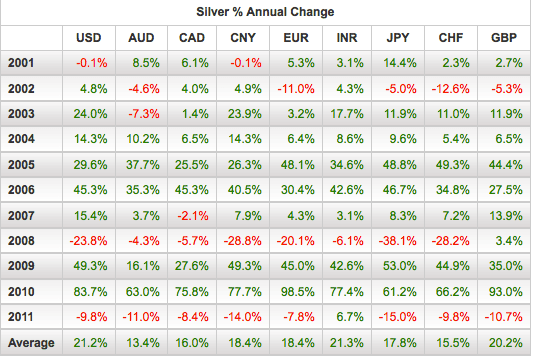Gold price rises again 11th consecutive year
Jan 4, 2012·James TurkGold has done it again. For the eleventh year in a row, the gold price rose in terms of US dollars.
Gold’s rate of exchange to the US dollar climbed 10.2% in 2011, so an arithmetic average of its annual rate of appreciation for the last eleven years when measured in the world’s reserve currency is a truly remarkable 17.7%.
Gold also rose in 2011 against each of the eight other major world currencies presented in the following table.

One year ago I asked the question whether gold can keep climbing higher? I answered with a resounding yes, that gold can keep moving on its upward path for the simple reason that we are witnessing the destruction of national currencies. My comments from last year I think capture exactly the reason for owning gold, and are therefore worth repeating:
“As long as governments and central bankers pursue policies that erode the purchasing power of the currency they manage, gold will be exchanged for that currency at an ever rising price.
It is important to recognise that all national currencies circulate because of government fiat, i.e., force. Governments use legal tender laws and other instruments of force to keep national currency in circulation. Because their purchasing power is being eroded, national currencies no longer meet the goals of what currency should be or the needs that currency should fill.
Gold is the numéraire – the measuring stick – that illustrates how badly national currencies are being managed. Therefore, unless government policies change – and I see no prospect of that – the price of gold will continue to rise.
Consequently, it still makes sense to stay with the same strategy that we have been pursuing throughout the last decade. Continue to accumulate gold under a steady cost averaging programme. Make gold purchases part of your regular budget, and view gold to be your savings. As I have said many times – but it is always worth repeating to understand the underlying logic of this gold accumulation plan – saving money is always a good thing, particularly when it is sound money. That conclusion is clear from the above table.”
The silver price fell in 2011 against most currencies, with the weak Indian rupee being the notable exception. Silver’s results are presented in the following table.

Even though its price declined last year, silver has generated average annual rates of appreciation in all nine currencies that are higher than gold. So silver also fits well within a long-term accumulation plan, but only if you are prepared to accept the volatility that comes with it. That volatility is evident from the above table. But the reward for accumulating silver will be its continuing outperformance against gold over the long-run.
It is interesting to note the precipitous fall in sentiment for gold and silver as 2011 came to a close. Consequently, one would think that the outlook for world currencies would be improving, making currencies a viable alternative for one’s liquidity needs. Remarkably, the case for owning physical gold and silver has only been strengthened by recent events. Not only do gold and silver preserve one’s purchasing power as the above tables attest, they do so without counterparty risk. They are tangible assets, and therefore their value is not based on any government, bank or indeed, anyone’s promise. Their value comes from countless people around the globe who recognise the unique attributes of the precious metals and their incomparable 5,000 year history as money.
To conclude, we should assume that gold and silver will both appreciate again in 2012. After all, many governments and central banks are pursuing the same policies they have been following for years that are destroying the purchasing power of national currencies. Add to that worry the worsening sovereign debt crisis and the insolvency of many of the world’s major banks. So the reasons for owning the precious metals are clear.
Gold and silver will preserve your wealth as the world’s experiment with fiat currencies – now 40 years old and failing badly – comes to an end. When it does, gold will return to its traditional and rightful role at the center of global commerce, while preserving the purchasing power of everyone who owns physical metal.
